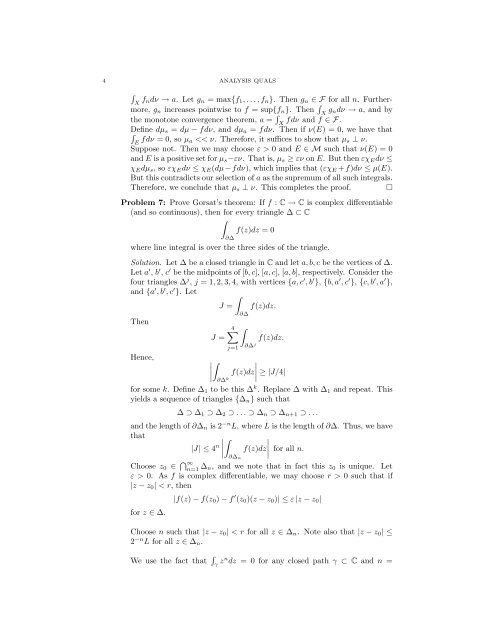ANALYSIS QUALIFYING EXAM PROBLEMS BRIAN LEARY ...
ANALYSIS QUALIFYING EXAM PROBLEMS BRIAN LEARY ...
ANALYSIS QUALIFYING EXAM PROBLEMS BRIAN LEARY ...
Create successful ePaper yourself
Turn your PDF publications into a flip-book with our unique Google optimized e-Paper software.
4 <strong>ANALYSIS</strong> QUALS<br />
<br />
X fndν → a. Let gn = max{f1, . . . , fn}. Then gn ∈ F for all n. Furthermore,<br />
gn increases pointwise to f = sup{fn}. Then <br />
X gndν → a, and by<br />
the monotone convergence theorem, a = <br />
fdν and f ∈ F.<br />
X<br />
Define dµs = dµ − fdν, and dµa <br />
= fdν. Then if ν(E) = 0, we have that<br />
E fdν = 0, so µa 0 and E ∈ M such that ν(E) = 0<br />
and E is a positive set for µs−εν. That is, µs ≥ εν on E. But then εχEdν ≤<br />
χEdµs, so εχEdν ≤ χE(dµ−fdν), which implies that (εχE +f)dν ≤ µ(E).<br />
But this contradicts our selection of a as the supremum of all such integrals.<br />
Therefore, we conclude that µs ⊥ ν. This completes the proof. <br />
Problem 7: Prove Gorsat’s theorem: If f : C → C is complex differentiable<br />
(and so continuous), then for every triangle ∆ ⊂ C<br />
<br />
f(z)dz = 0<br />
∂∆<br />
where line integral is over the three sides of the triangle.<br />
Solution. Let ∆ be a closed triangle in C and let a, b, c be the vertices of ∆.<br />
Let a ′ , b ′ , c ′ be the midpoints of [b, c], [a, c], [a, b], respectively. Consider the<br />
four triangles ∆ j , j = 1, 2, 3, 4, with vertices {a, c ′ , b ′ }, {b, a ′ , c ′ }, {c, b ′ , a ′ },<br />
and {a ′ , b ′ , c ′ }. Let<br />
Then<br />
<br />
J =<br />
J =<br />
Hence, <br />
∂∆<br />
4<br />
<br />
j=1<br />
∂∆ j<br />
f(z)dz.<br />
f(z)dz.<br />
<br />
<br />
f(z)dz<br />
≥ |J/4|<br />
∂∆k for some k. Define ∆1 to be this ∆k . Replace ∆ with ∆1 and repeat. This<br />
yields a sequence of triangles {∆n} such that<br />
∆ ⊃ ∆1 ⊃ ∆2 ⊃ . . . ⊃ ∆n ⊃ ∆n+1 ⊃ . . .<br />
and the length of ∂∆n is 2−nL, where L is the length of ∂∆. Thus, we have<br />
that<br />
|J| ≤ 4 n<br />
<br />
<br />
<br />
<br />
<br />
<br />
f(z)dz<br />
for all n.<br />
∂∆n<br />
Choose z0 ∈ ∞<br />
n=1 ∆n, and we note that in fact this z0 is unique. Let<br />
ε > 0. As f is complex differentiable, we may choose r > 0 such that if<br />
|z − z0| < r, then<br />
for z ∈ ∆.<br />
|f(z) − f(z0) − f ′ (z0)(z − z0)| ≤ ε |z − z0|<br />
Choose n such that |z − z0| < r for all z ∈ ∆n. Note also that |z − z0| ≤<br />
2 −n L for all z ∈ ∆n.<br />
We use the fact that <br />
γ zn dz = 0 for any closed path γ ⊂ C and n =
















